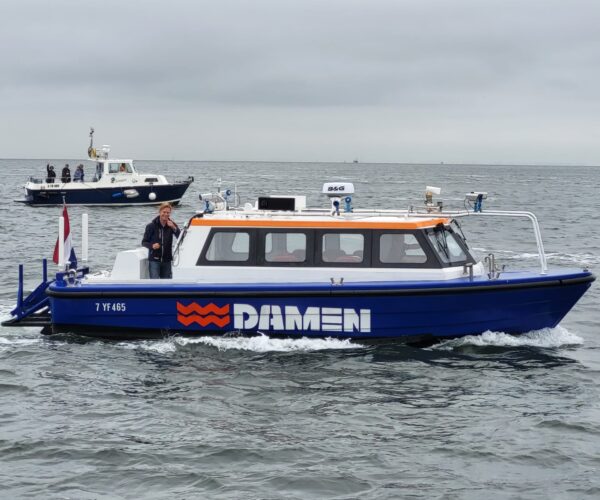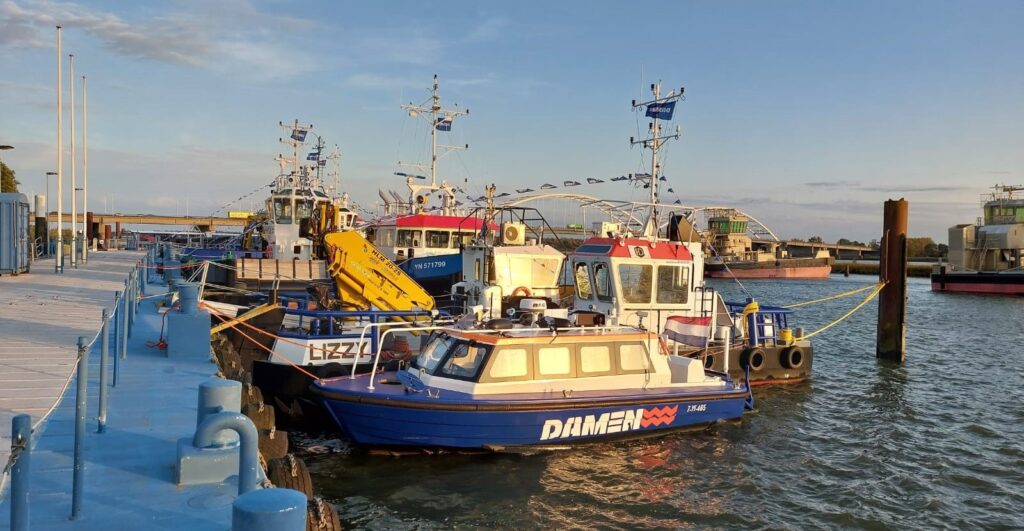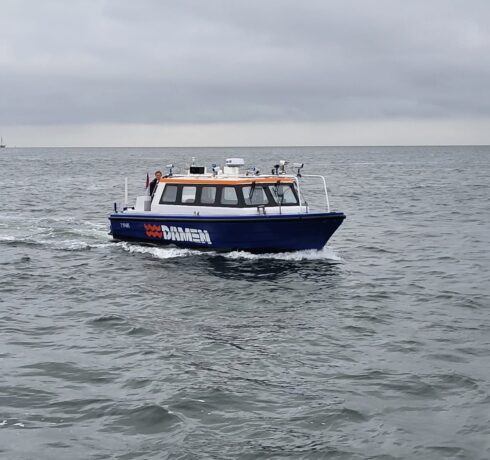The last time that the Schelde Schakels spoke to Jochem Nonhebel, Project Leader of Damen Naval’s F.A.S.T. (Fieldlab Autonomous Sailing Technology) project, he was making the final preparations to sail to the SAIL Den Helder maritime festival. Back then, he was still undecided as to what route he would be taking: the inland or the coastal route. So, which one did he choose? “We decided to go the coastal route,” he replies. “It was a good trip up north; we took eight hours to sail from Vlissingen to Den Helder.”
Visiting SAIL Den Helder was the perfect opportunity to put the nine-metre F.A.S.T. boat in the spotlight, says Jochem. “We offered free trips to the public which was great because we had very good weather. And it was especially nice to take some of the Damen Naval board members out on our boat.”
 Project F.A.S.T. Project Leader Jochem Nonhebel on board the Stan Patrol 900.
Project F.A.S.T. Project Leader Jochem Nonhebel on board the Stan Patrol 900.
Of course, PR is important. But only to a certain extent. For a project aiming to develop an autonomous vessel, nothing beats data collection. “Sailing up to Den Helder gave us lots of data from a coastal environment and the chance to test our auto pilot which proved itself to be very reliable,” says Jochem. “And then during the four days of SAIL, we could collect data from a harbour environment. The last day was particularly interesting: the wind was blowing a five or six [Beaufort] so there was quite a lot of waves. We got to see how the sensors and camera behaved in those conditions. We recorded a lot of data, which we are analysing at the moment, and we will be drawing our conclusions not too long from now.”
Next up in the Project F.A.S.T. agenda was a demonstration event in Gent, Belgium on 19 and 20 September, followed by further data collection on the Westerschelde estuary on the 21st. “This was not open to the public – it was more of a technical event during which we wanted to show our level of technical maturity. Two other projects were there too: the Belgian Avatar project and one from MARIN.” Just as with the trip to SAIL Den Helder, Jochem is aware of the importance of increasing the awareness of autonomous shipping to the public. “We recorded all our software screens and took some drone footage, all of which we can use for PR purposes,” he says.
“An autonomous vessel must be able to distinguish between a jet ski and a sailing yacht. These two vessel types not only have different top speeds, but also have different rights of way." Jochem Nonhebel
This technical event “tested the vessel, software and sensors” explains Jochem. “In the harbour at Gent, this involved pre-organised and pre-programmed situations at low speeds. And on the Westerschelde, we did similar actions but at higher speeds to show that we are not only able to detect and avoid smaller objects, but large ships too – running our algorithms in this relevant and real-scale environment.” The event was a success, with representatives from the Belgium and Dutch pilot associations, as well as from the Royal Netherlands Navy, showing their interest. “This was not a smooth sales demonstration, but rather a raw technology ‘show-off’ during which we learned a lot, cached a lot of drone footage, and made some new connections.”
 The demonstration events are perfect to test the vessel, software and sensors in different conditions and situations.
The demonstration events are perfect to test the vessel, software and sensors in different conditions and situations.
It is clear that Project F.A.S.T. is collecting a considerable amount of data. But how is this data analysed? “We have to turn the data – from sensors, radars and cameras – into relevant information,” answers Jochem. “The camera data is used to detect and classify objects. For example, is the object a sailing yacht, a buoy, or a canoe. The radar images are very useful at telling us the distance from our vessel to the object. Radar is also good at tracking objects: is it static like the shoreline? Or is it moving? And how fast is it moving? Combining these two sets of data allows you to make a plan.”
This aspect of ‘making a plan’ is the absolute essence of autonomous shipping. “An autonomous vessel must be able to distinguish between a jet ski and a sailing yacht. These two vessel types not only have different top speeds, but also have different rights of way,” Jochem says. “On top of that, the environment is constantly changing, and your own vessel is not staying in the same position. It is difficult to implement all this into the decision-making software, but we are making the first steps.”
 Project F.A.S.T. sailed to Damen HQ in Gorinchem for the Damen Maritime Festival.
Project F.A.S.T. sailed to Damen HQ in Gorinchem for the Damen Maritime Festival.

